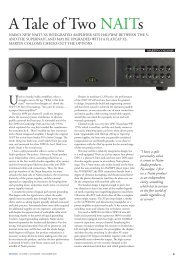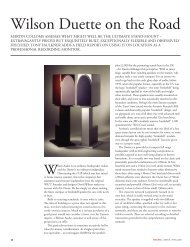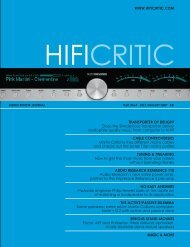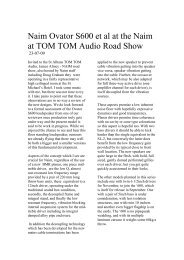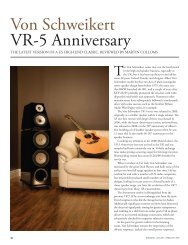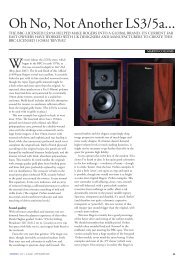HFC16_Krell reprint.indd - Hificritic.com
HFC16_Krell reprint.indd - Hificritic.com
HFC16_Krell reprint.indd - Hificritic.com
You also want an ePaper? Increase the reach of your titles
YUMPU automatically turns print PDFs into web optimized ePapers that Google loves.
<strong>Krell</strong> S-300i Integrated Amplifier<br />
A POCKET BATTLESHIP OF AN INTEGRATED AMPLIFIER BY MARTIN COLLOMS<br />
The very first thing that impressed me<br />
about this ‘first from China’ <strong>Krell</strong> (origin<br />
unambiguously printed on the rear panel),<br />
was the sheer mass of the packed unit: 23kg/51lb<br />
bodes well for build quality and for the large power<br />
rating of the mains transformer. The Editor is wont<br />
to <strong>com</strong>ment how often mass, or more specifically<br />
density, provides a useful guesstimate of possible<br />
loudspeaker performance, particularly when<br />
<strong>com</strong>paring like models in a group test. I have found<br />
that this can also be true for audio electronics, except<br />
where examples are deliberately built of special<br />
lightweight materials.<br />
The central volume rotary encoder has a<br />
secondary function as a control and data input<br />
for selecting various operating modes, many of<br />
which allow the user to customise the inputs, their<br />
sensitivity and channel balance offset if required, plus<br />
display dim and auto off functions.<br />
<strong>Krell</strong>’s KID iPod dock featured an analogue,<br />
balanced audio interface to an iPod’s multi-pin<br />
connection. Costing little more than the KID dock,<br />
the S-300i now includes a balanced ‘audio pod’<br />
connection, via a sufficiently long included cable,<br />
rather than a physical dock. Like the KID, it allows<br />
iPod album and track selection, play, pause etcetera<br />
via a dedicated keypad section on the main <strong>Krell</strong><br />
remote control. It’s helpful to be able to see the iPod<br />
screen while using these controls.<br />
<strong>Krell</strong> has provided some revealing data about the<br />
£2,400 S-300i which hints at the potential available.<br />
Good eco-friendliness is promised by the claimed<br />
low 20W standby power, despite the toroidal mains<br />
transformer’s large 750VA rating. However my VI<br />
meter contradicts this claim, measuring 42W/68VA<br />
on standby and 68W/104VA when ‘on’ at moderate<br />
volume (ie that of an average tungsten light bulb),<br />
and rather different from the spec. Nevertheless it is<br />
still quite low by audiophile product standards.<br />
On the basis that the mains transformer is<br />
larger than found in many good sized free-standing<br />
power amplifiers, the 2x150W 8ohms, 2x300W<br />
4ohms power output rating looks conservative,<br />
and I’d suspect that more like 200W and 400W/<br />
ch respectively will actually be available into real<br />
loudspeaker loads, making this a very powerful<br />
integrated amplifier indeed.<br />
This model’s US built predecessor, the KAV<br />
300i sold for about £3,000 in 1996, so the cost<br />
saving for the new build location has dealt a death<br />
blow to nearly 15 years of inflation. While the<br />
power output ratings for the old and the new are<br />
roughly <strong>com</strong>parable, the earlier design had four<br />
8,200uF Nichicon reservoir capacitors, a smaller<br />
450VA transformer, and idled at 50W. The new has<br />
four 4,700uF reservoirs per channel and of course<br />
that much larger toroid. There are double mono<br />
secondary supplies and reservoirs with four pairs of<br />
high current output transistors per channel. This is<br />
not a bridged design.<br />
The surface mount technology gives very short<br />
signal paths on the central circuit board. Control<br />
of DC offset for signal handling, in particular<br />
the fully balanced input, is allocated to a number<br />
of high precision Burr Brown OP177 op-amps.<br />
Also embedded is the 151-step analogue volume<br />
control, an FET-switched miniaturised surfacemount<br />
precision resistor ladder controlled via a<br />
microprocessor and a front panel rotary encoder<br />
volume knob. While miniaturised, <strong>Krell</strong>’s traditional<br />
discrete transistor symmetric array amplifier are<br />
present. These symmetric DC coupled very wide<br />
band stages are essentially immune from slewing<br />
with audio bandwidth signals.<br />
Build and finish is very good, like a standard <strong>Krell</strong><br />
EVO pre-amp. The power switch is on the rear panel<br />
next to the IEC mains connection, and the speaker<br />
terminal layout is sensible, with easy access ‘WBT<br />
38 HIFICRITIC OCTOBER | NOVEMBER | DECEMBER 2009




